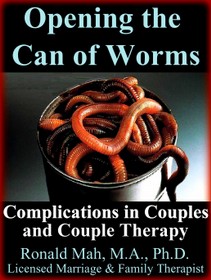8. Post-Traumatic Stress Disorder - RonaldMah
Ronald Mah, M.A., Ph.D.

Licensed Marriage & Family Therapist,
Consultant/Trainer/Author
Main menu:
8. Post-Traumatic Stress Disorder
Therapist Resources > Therapy Books > Opening the Can of Worms-Cple

Opening the Can of Worms, Complications in Couples and Couple Therapy
Chapter 8: POST-TRAUMATIC STRESS DISORDER (PTSD)
by Ronald Mah

In stark contrast to some bipolar individuals who may voluntarily choose or allow his or her condition to manifest, individuals with overwhelming chronic stress or acute stress that constitute trauma often struggle futilely to hold symptoms at bay. Motamedi (2011) provides a summary of the physiological effects of stress. "Confronted by danger, the brain's sympathetic adrenal medullary, or SAM, axis kicks into gear, and the adrenal gland starts to flood the body with epinephrine and norepinephrine. Together, these stress hormones trigger a cascade of changes: blood pressure rises, heartbeat quickens, blood vessels constrict. The body is ready to fight - or flee. But once danger abates, the body strives for balance: The hypothalamic-pituitary-adrenal, or HPA, axis takes over and the adrenal gland starts releasing cortisol, which slows the body down and restores equilibrium. When they work, SAM and HPA are like two ends of a teeter-totter, raising the body's defenses to danger and then lowering them as danger disappears. But overstimulation - too much stress, too often – throws the balance off… Researchers warn that a constant flood of epinephrine and norepinephrine can suppress immune systems; provoke variations in heart rhythms; produce neurochemical imbalances that cause psychiatric disorders; and destroy neurons in the hippocampus, where today's pop quiz becomes tomorrow's ability to write long essays or solve complex equations.
A key element to trauma is that despite the body's instinct and preparation to fight or flee, the individual is unable to fight effectively or functionally flee to get away or eliminate danger. Although the body and mind is flooded with hormonal changes, it does not work. Danger remains and the individual suffers the physical, mental, and psychological consequences. While the HPA system may be able to rebalance the physiological system, trauma that becomes post-traumatic stress disorder (PTSD) stays within the mental and psychological system. It lingers out of sight and consciousness, only to erupt unbidden and uncontrollable when triggered. Trauma like mania or addiction becomes the third partner in the couple. As an intrusive ambushing partner, trauma injects out of control emotional and behavioral reactivity into the partners' lives. A more layered and complex therapeutic process may be necessary since, "Hours spent in solution-talk will not stop traumatized clients from being overwhelmed by rage or panic when faced with the old triggers" (Schwartz and Johnson, 2000, page 30). PTSD symptoms continue to be destructively illogical despite the desires and efforts of the affected partner and the other partner. Whereas partners usually want to collaborate and work toward positive resolutions, the trauma, mania, or addiction acts as an emotionally reactive free agent unaligned with couple's goals. Individuals with PTSD are challenged to consistently engage in the emotional expression that builds intimate relationships.
Emotional expression and connection are compromised because of "…symptoms of emotional numbing (i.e., loss of interest in activities, detachment from others, restricted affect) contribute to relationship distress. Similarly, hyperarousal symptoms of PTSD, such as irritability and concentration problems, may adversely affect the way that the couple approaches problems, increasing conflict and distress within the relationship. Difficulties in intimate relationships may, in turn, contribute to the persistence of posttraumatic symptoms (Barrett & Mizes, 1988; Beiser, Turner, & Ganesan, 1989; Davidson, Hughes, Blazer, & George, 1991; Solomon, Waysman, & Mikulincer, 1990)" (Riggs et al., 1998, page 88). Partners who tend towards avoidance and emotional numbing negatively affect the relationship more than effortful avoidance symptoms. Individuals with PTSD-caused emotional numbing may cause a deficit in the experience and/or expression of positive emotions critical to positive functioning relationships. "…the absence of positive feelings toward a partner or the inability to express those feelings would likely diminish the quality of the relationship. Thus, the numbing of positive emotions associated with PTSD may contribute directly to difficulties in maintaining or establishing positive intimate relationships" (Riggs et al., 1998, page 98).
While every person encounters stress that is challenging, extraordinary stress that destabilizes functioning is considered to be trauma. Key to the diagnosis of post-traumatic stress disorder is extended life of the trauma. Whereas the immediate effect of the trauma may be physically, emotionally, psychologically, intellectually, and spiritually devastating, for some individuals the trauma reoccurs and disrupts ongoing functioning and relationships. The Diagnostic and Statistical Manual, Fourth Edition (American Psychiatric Association, 2000) presents the following description and criteria for post-traumatic stress disorder:
Criterion A: stressorThe person has been exposed to a traumatic event in which both of the following have been present:
1. The person has experienced, witnessed, or been confronted with an event or events that involve actual or threatened death or serious injury, or a threat to the physical integrity of oneself or others.2 The person's response involved intense fear, helplessness, or horror. Note: in children, it may be expressed instead by disorganized or agitated behavior.
Criterion B: intrusive recollectionThe traumatic event is persistently re-experienced in at least one of the following ways:
1. Recurrent and intrusive distressing recollections of the event, including images, thoughts, or perceptions. Note: in young children, repetitive play may occur in which themes or aspects of the trauma are expressed.2. Recurrent distressing dreams of the event. Note: in children, there may be frightening dreams without recognizable content3. Acting or feeling as if the traumatic event were recurring (includes a sense of reliving the experience, illusions, hallucinations, and dissociative flashback episodes, including those that occur upon awakening or when intoxicated). Note: in children, trauma-specific reenactment may occur.4. Intense psychological distress at exposure to internal or external cues that symbolize or resemble an aspect of the traumatic event.5. Physiologic reactivity upon exposure to internal or external cues that symbolize or resemble an aspect of the traumatic event
Criterion C: avoidant/numbingPersistent avoidance of stimuli associated with the trauma and numbing of general responsiveness (not present before the trauma), as indicated by at least three of the following:
1. Efforts to avoid thoughts, feelings, or conversations associated with the trauma2. Efforts to avoid activities, places, or people that arouse recollections of the trauma3. Inability to recall an important aspect of the trauma4. Markedly diminished interest or participation in significant activities5. Feeling of detachment or estrangement from others6. Restricted range of affect (e.g., unable to have loving feelings)7. Sense of foreshortened future (e.g., does not expect to have a career, marriage, children, or a normal life span)
Criterion D: hyper-arousalPersistent symptoms of increasing arousal (not present before the trauma), indicated by at least two of the following:
1. Difficulty falling or staying asleep2. Irritability or outbursts of anger3. Difficulty concentrating4. Hyper-vigilance5. Exaggerated startle response
Criterion E: duration
Duration of the disturbance (symptoms in B, C, and D) is more than one month.
Criterion F: functional significance
The disturbance causes clinically significant distress or impairment in social, occupational, or other important areas of functioning.
Specify if:
Acute: if duration of symptoms is less than three monthsChronic: if duration of symptoms is three months or more
Specify if:
With or Without delay onset: Onset of symptoms at least six months after the stressor (APA, 2000, page 427-28).
Depending on the individual's self-awareness and insight, along with cultural expectations, trauma may be minimized or ignored. Individuals may come from societies where devastating environmental events (earthquake, floods, tornados, drought, and so forth), unpredictable and periodic violent events (purges, genocide, homicide, renegade and institutional mayhem or persecution), medical vulnerability to untreatable illness and disease along with high infant mortality, and other mortal events are commonplace or part of the fabric of living. American mainstream experiences and situations would be distinctly different for most Americans. Spasojevic' et al (2000) discussed that the acculturation differences among immigrants and refugees relating to marital problems. Their survey of studies found inconsistencies with some studies finding partner differences in resistance to American acculturation correlated to marital problems while other studies found no differences (page 207). Among Bosnian refugees, there is an interesting finding "that wives' global marital distress was better predicted by their husbands' PTSD symptomatology than by their own. This may indicate wives' orientation toward others (especially toward her partner) and the strong patriarchal component of Bosnian culture" (Spasojevic' et al, 2000, page 213-14). Examination of further studies lead to a less than authoritative finding that "More highly acculturated individuals had a somewhat lower rate of marital problems." Most, but not all previous studies relate levels of acculturation to psychopathology. Several studies (studies with Southeast Asian refugees (Westermeyer, Neider, & Callies, 1989), Greek Cypriot immigrants (Adamopoulou, Garyfallos, Bouras, & Kouloumas, 1990), Iranian immigrants (Ghaffarin, 1987), and Mexican Americans (Golding & Burnam, 1990) found that those who were less acculturated showed higher levels of psychological distress. PTSD symptoms strongly predicted problems in many areas of the marital relationship among Bosnian refugee couples. Communication distress had the strongest correlation with PTSD. Trauma experiences were not or only rarely discussed with others in the family. As a result, "Family members, each with his or her own trauma, often become isolated from one another, which can result in both communication breakdown and marital distress" (Spasojevic' et al, 2000, page 213).
American culture tends to have standards of more open and shared communication between partners about distressing prior and current experiences. However, there is significant variation among people. The therapist who prompts revelation of the inner experiences of a partner may be making these experiences available to the other partner for the first time. Implicit and explicit cultural and family sanctions against personal self-disclosure and inquiry of the other's inner processes may have precluded sharing of important experiences with anyone including or especially ones partner. This could include trauma. The therapist may be of necessity a cultural or family model rule breaker in order to get to underlying issues that affect the individual and the relationship. From experience and training, the therapist may not have an applicable authoritative interpretation of cultural models or acculturation readily applicable to a couple. There are often nuanced interpretations of findings and of the couple that require careful assessment.
For example, "Interestingly, in this study wives' acculturation was not strongly associated with either her or her husband's PTSD, whereas husbands' acculturation showed a strong relation to both marital partners' PTSD symptoms. Several potential explanations can be offered for the PTSD–acculturation relation observed here. For example, the more highly acculturated refugees may experience less acculturative stress, thus lowering their rates of PTSD. Also, refugees with higher acculturation may comprise a subpopulation of refugees who 'throw themselves into new life without looking back' and this style of coping may be helpful in dealing with PTSD. It is also possible that refugees with more severe PTSD immigrating to the United States may find it more difficult to acculturate. Regardless of its source, this basic correlational finding may be of use to mental health and social work professionals in recognizing that refugees with lower acculturation are at greater risk for developing or having PTSD" (Spasojevic' et al, 2000, page 214). Assuming that more acculturated refugees would have lower rates of PTSD may be another way to frame PTSD conceptualization as a strongly American professional/cultural definition or conceptualization. Likewise there may be gender differences as well as American sub-culture differences in PTSD conceptualization. It would be of interest to find if partners in the studies self-identify themselves with PTSD based on their experiences and culture. The therapist when working with any client may find that his or her self-diagnosis may be foreign to the partners- that is, outside of his or her personal conceptual reality. The psycho-educational aspect of therapy may require a cross-cultural presentation to be effective.

